Henrik Rydström has brought a new tactical approach to Malmö FF, transforming the team with his innovative strategies and dynamic style of play. This article delves into a detailed tactical analysis of Malmö FF under Rydström’s leadership. We explore the formations, key player roles, and strategic maneuvers that define their gameplay. Join us as we break down the tactical elements that make Malmö FF a formidable force in the league under Henrik Rydström’s guidance.
Build-up
Henrik Rydström’s Malmö FF exemplifies a unique brand of football characterized by relationism and high fluid build-up. At the heart of Rydström’s philosophy is the concept of relationism, emphasizing the interconnectedness and synchronization of players across the pitch. This approach prioritized building cohesive relationships between players, facilitating intricate passing sequences and fluid movement off the ball. In the build-up phase, Malmö are committed to maintaining possession through intricate passing triangles and dynamic positional rotations. By encouraging players to constantly adjust their positions to create passing lanes and numerical superiority, Rydström fosters a style of play that enables Malmö to control the game’s tempo and dictate play from the back. Initially, they usually set up in a 1-4-2-3-1 or 1-4-3-3 formation, but the players constantly rotate into new shapes during the game.
Tilting
In the high build-up, Rydström’s Malmö usually tilt over to one side, pushing every player (apart from the weak-side fullback sometimes) over to the ball-side.
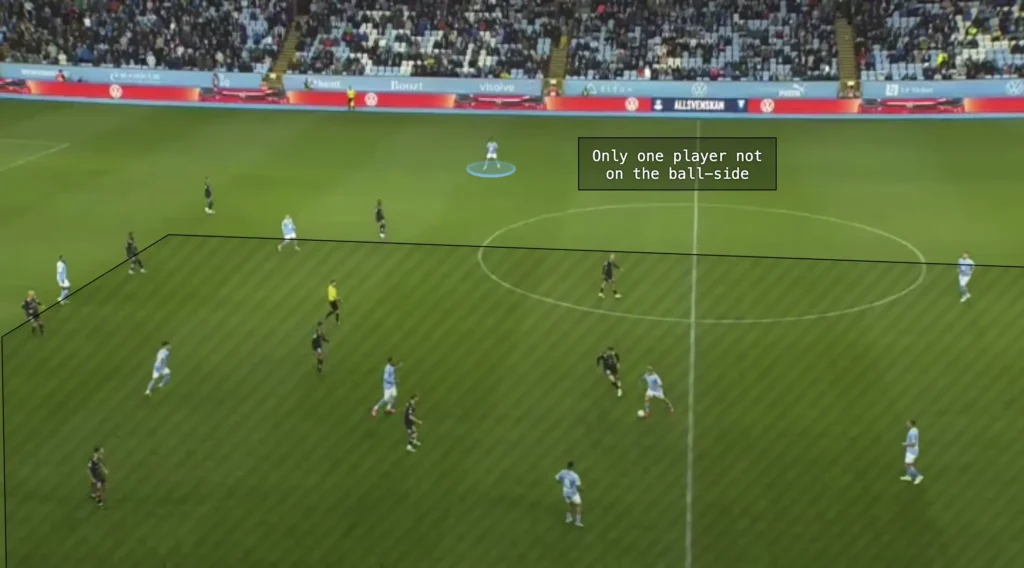
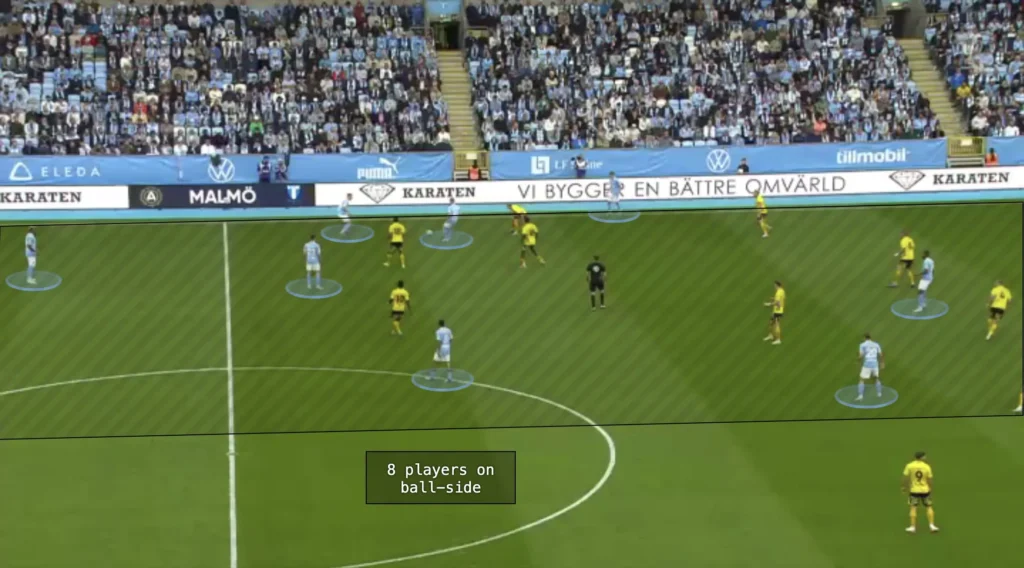
Having the players close to each other creates more options for the ball-holder and less space between the players. Rydström likes this because it builds good conditions in defensive transitions while making it easier to play through the opposition. Keeping many players close together shortens the distances between them. This shortens the length of the passes, which naturally shortens the time between passes. This means the opposition players will have less time to push up and press, giving the Malmö players more time and control.
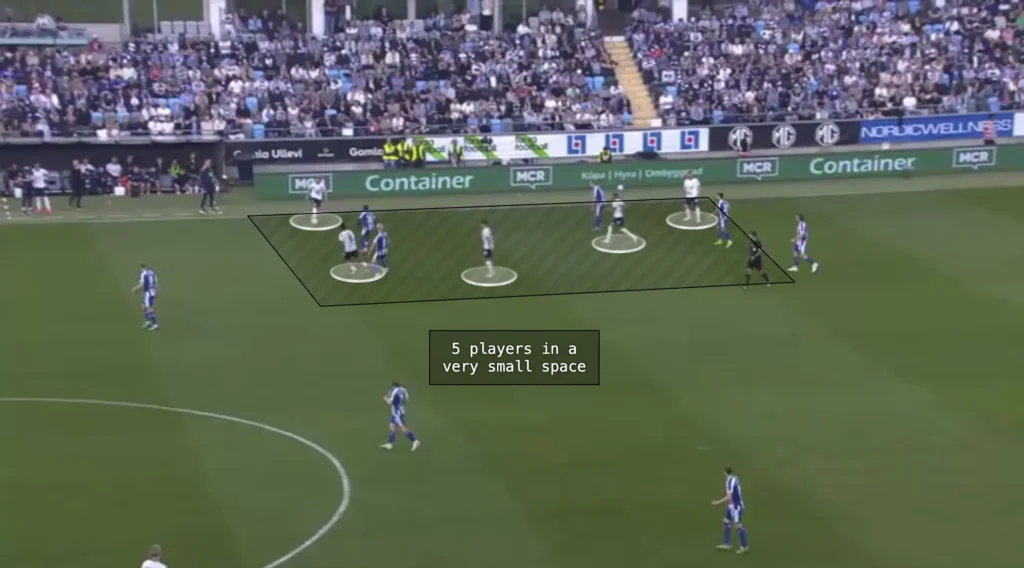
Because they tilt over to one side, they rarely switch sides, often focusing the play on the side that they are on. Many teams know this and, therefore, leave the weak-side completely open. Due to this, the weak-side fullback sometimes pushes up into this space, allowing Malmö to use the switch of play to create a 1v1 situation.
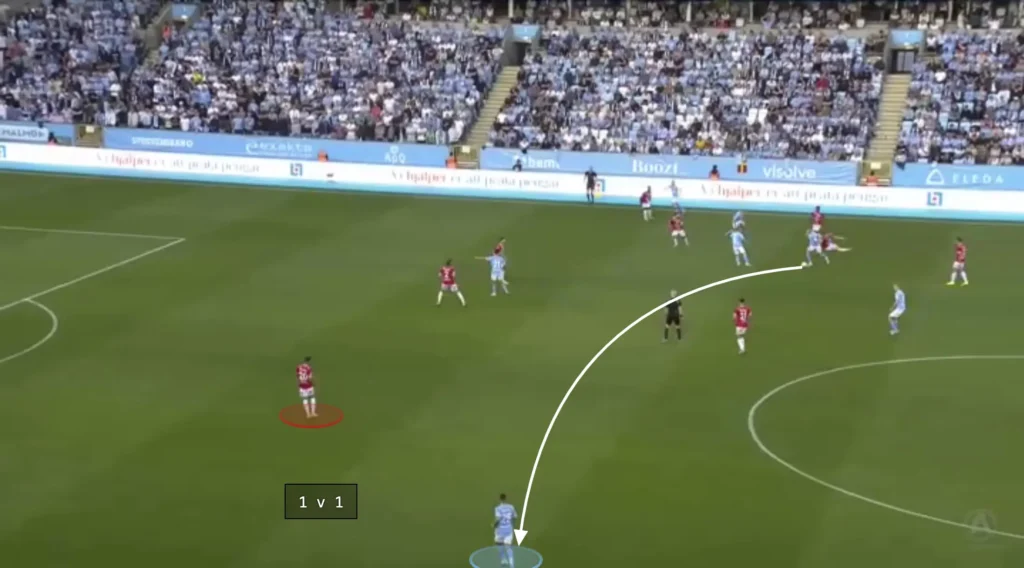
Numerical Advantages
A notable aspect of Malmö’s unique build-up is their ability to create numerical advantages against the opposition in different areas of the pitch. Their fluidity and constant rotations are structured in a way where the players look to exploit the spaces where the opposition is weak. Their main target is usually the opposition fullback, focusing many players around him to create an advantage there.
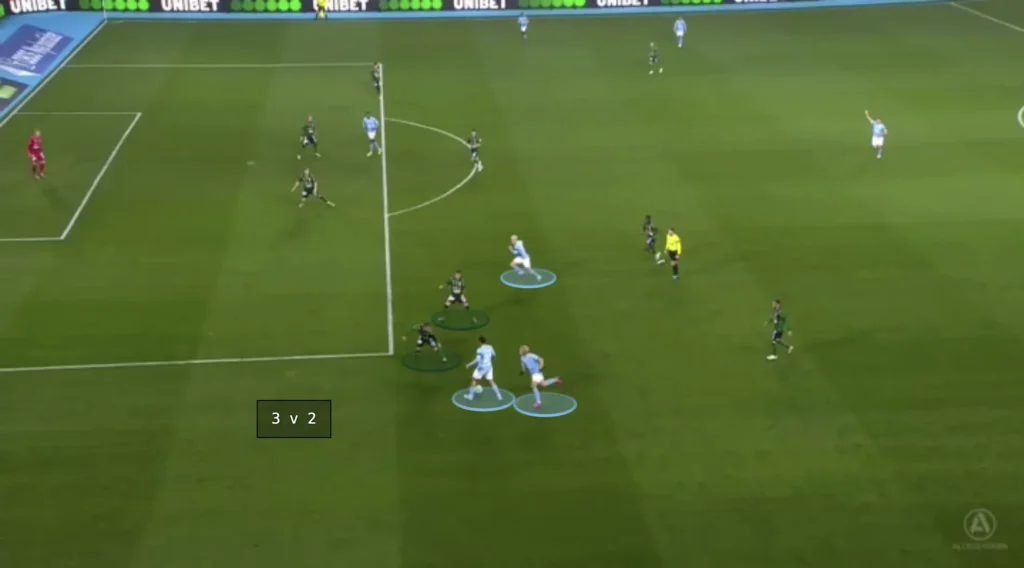
Principles and Tools
Keeping Possession
Under Rydström’s guidance, Malmö FF epitomizes a possession-oriented style of play that emphasizes control and fluidity on the ball. Rydström instills a philosophy deeply rooted in ball retention, encouraging his players to circulate possession patiently while probing for openings in the opposition’s defense. The team showcases intricate passing sequences, often building from the back with composure and precision. Players are instructed to seek numerical superiorities, utilizing short, quick passes to maintain possession and dictate the tempo of the game.
Third-man
Henrik Rydström, as established, wants his team to play through the opposition when possible. One vital tool that they often use is the third-man principle. This means using a third player to reach a free player whose passing lane is blocked. They mainly do this to find players between the opposition’s backline and midfield. Getting the ball in these pockets allows them to turn and attack the defense, often resulting in goalscoring opportunities.
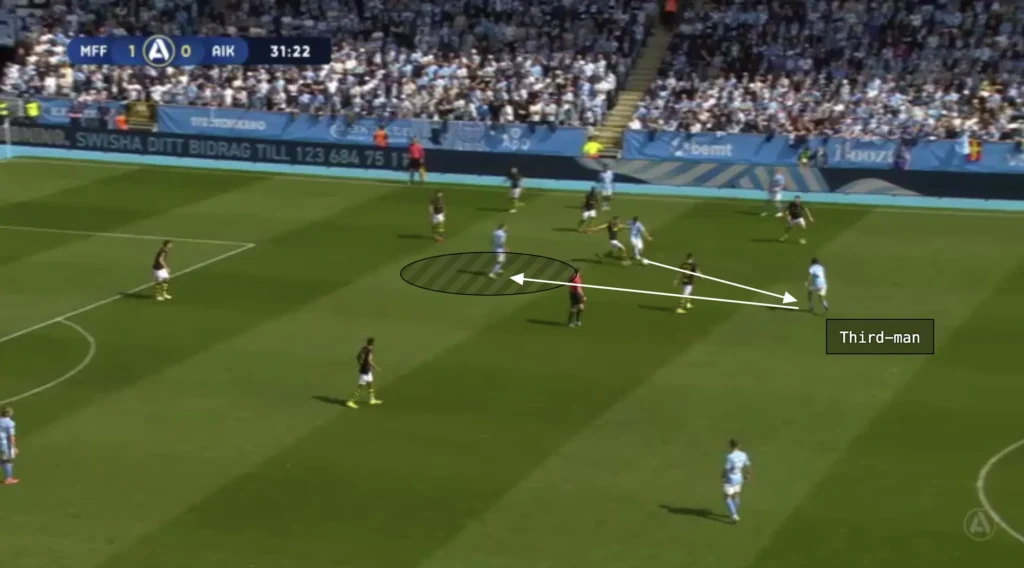

Give and Go
One influential principle of Rydström’s Malmö FF is to always move after passing the ball. This is a massive part of Malmö’s fluidity, creating new positions and passing opportunities every second.
One-Two
An extension of Malmö’s constant movement is one-twos. The players always move after passing the ball, giving the player who received the ball the option to give it back in a new space. The one-two is extremely hard to defend and has become a vital tool in Malmö’s high build-up.
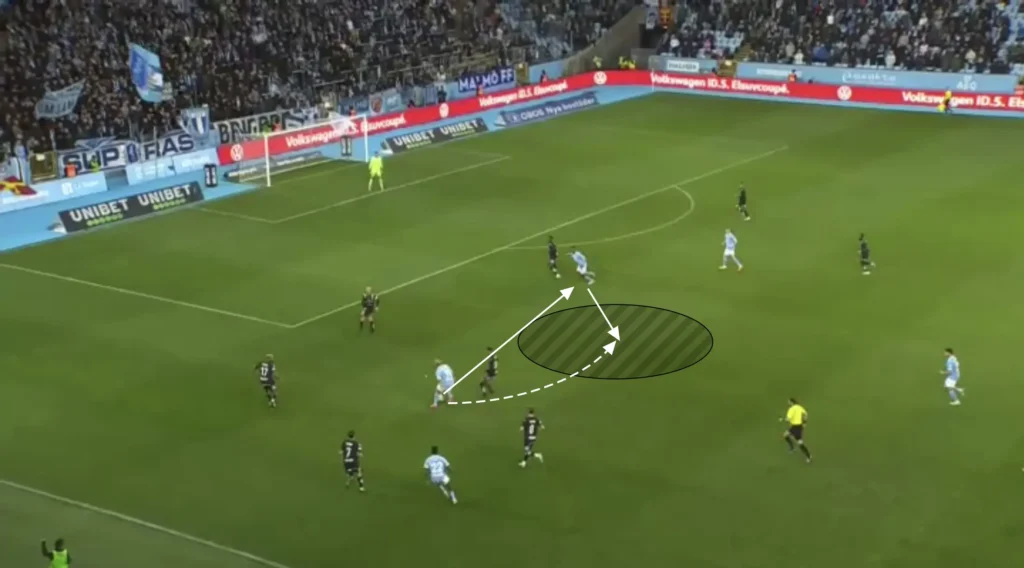
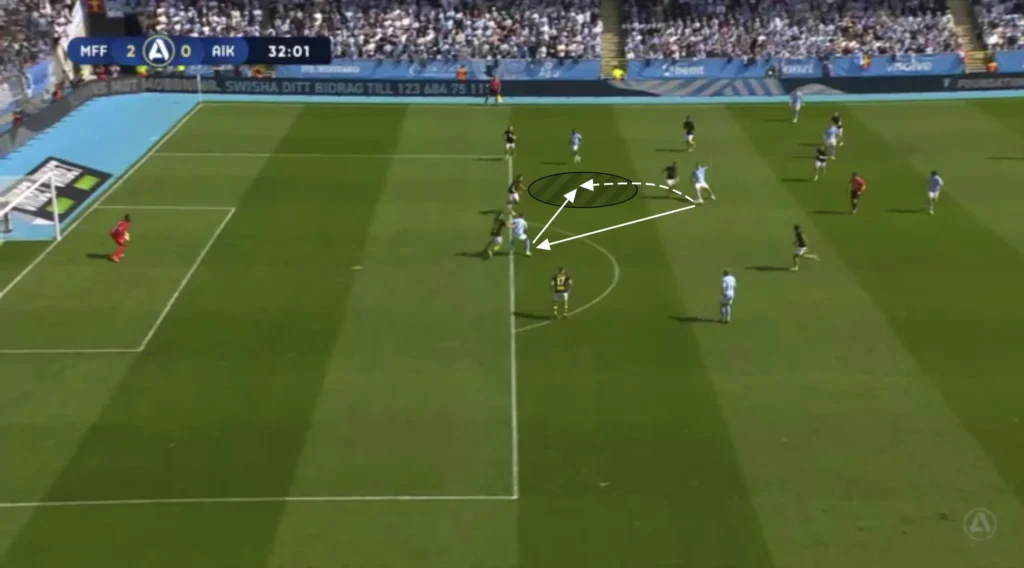
Diagonal Lines
Malmö FF also look to create diagonal lines between the players during their build-up. They will often be seen in lines of three or four players working together to beat the opposition’s defense.
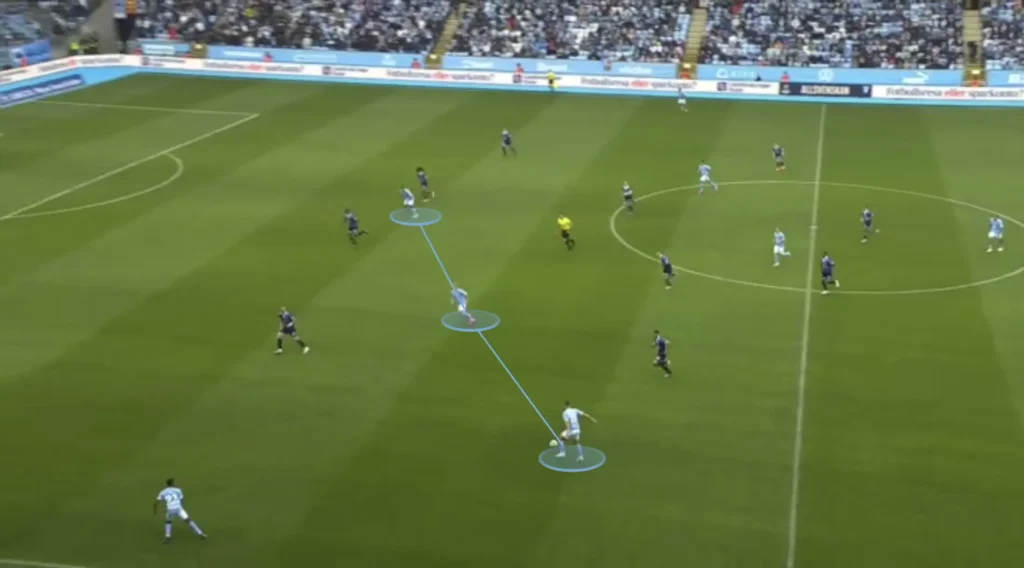
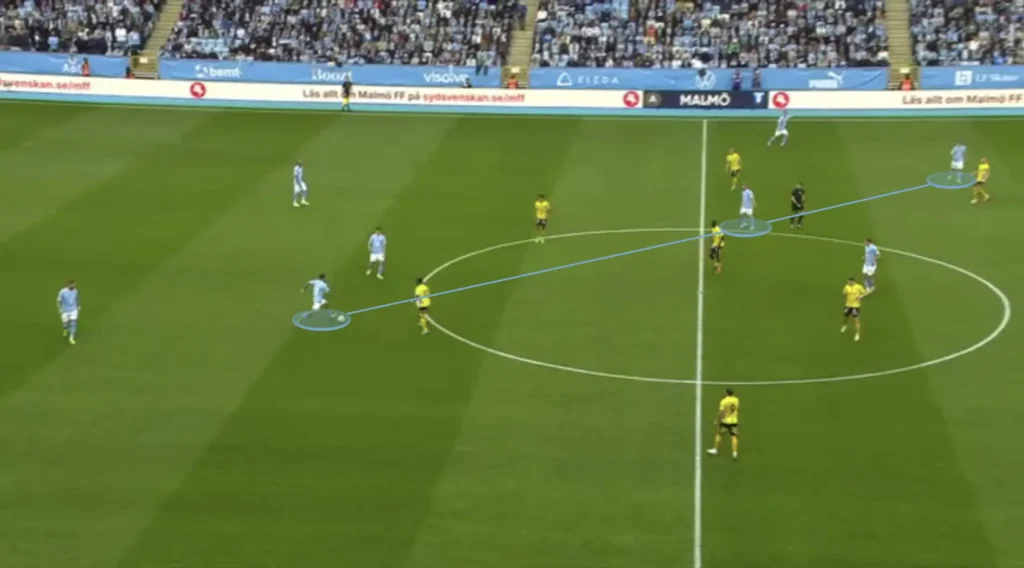
They can exploit these lines in different ways. The “middle player” in the line can open the passing lane to the furthest player by making a run in behind. The furthest player can then play the ball to the running player, whose run is difficult to track. The “middle player” can also jump over the ball to confuse the opponents into not knowing who is receiving the ball.
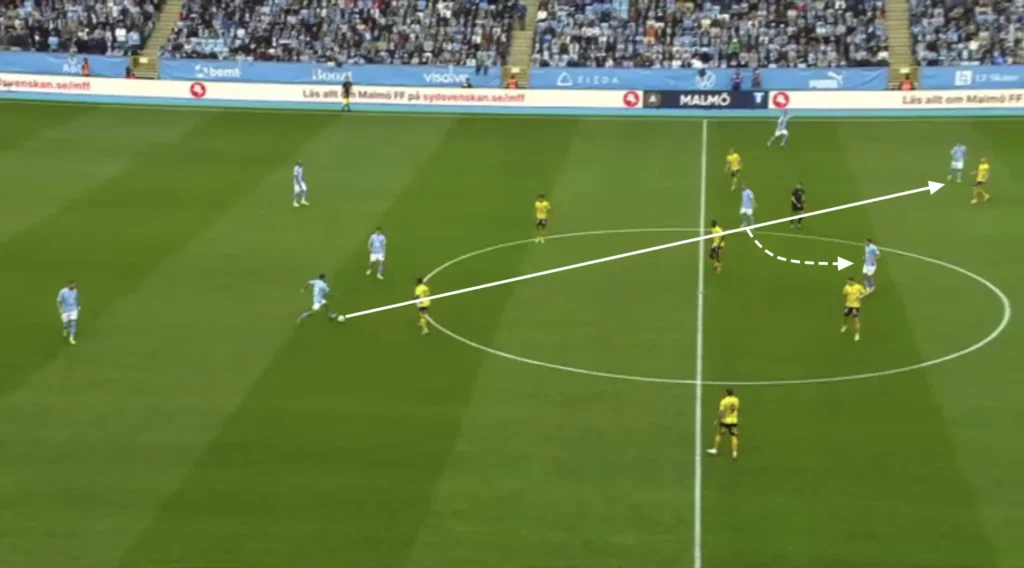
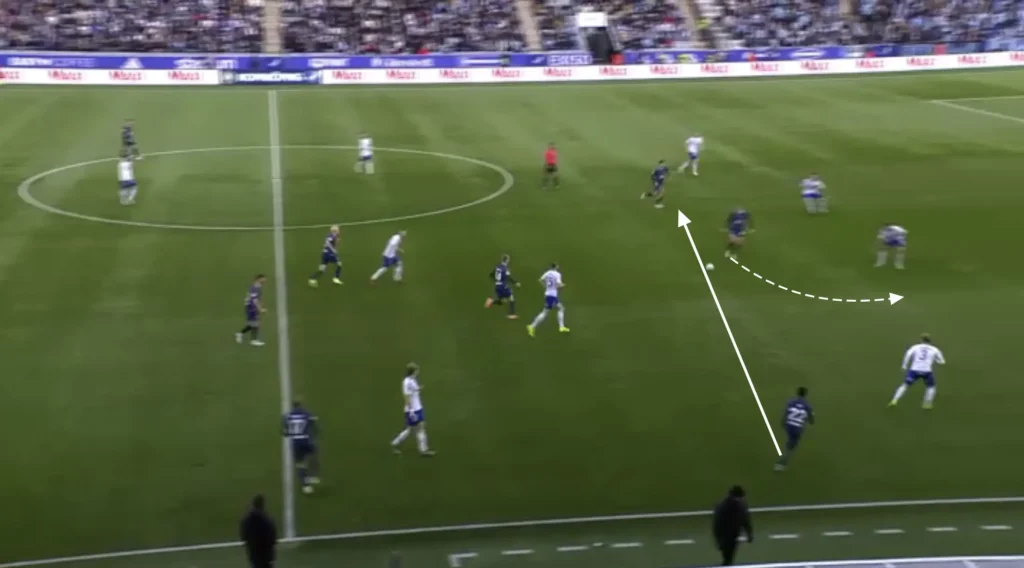
Final Third
Attacking the Half-Space
Malmö is an excellent team in the final third. They create many chances, mainly by attacking the space between the opposition center-back and fullback. They primarily do this from the wide areas with underlaps from midfielders. The Malmö winger will get the ball on the wing and attack the opposition fullback. A Malmö midfielder will make the underlapping run between the opposition center-back and fullback. The winger can either take the ball inside to combine with an attacker or shoot, or he can play the ball to the underlapping player, who can cross to a teammate in the box.
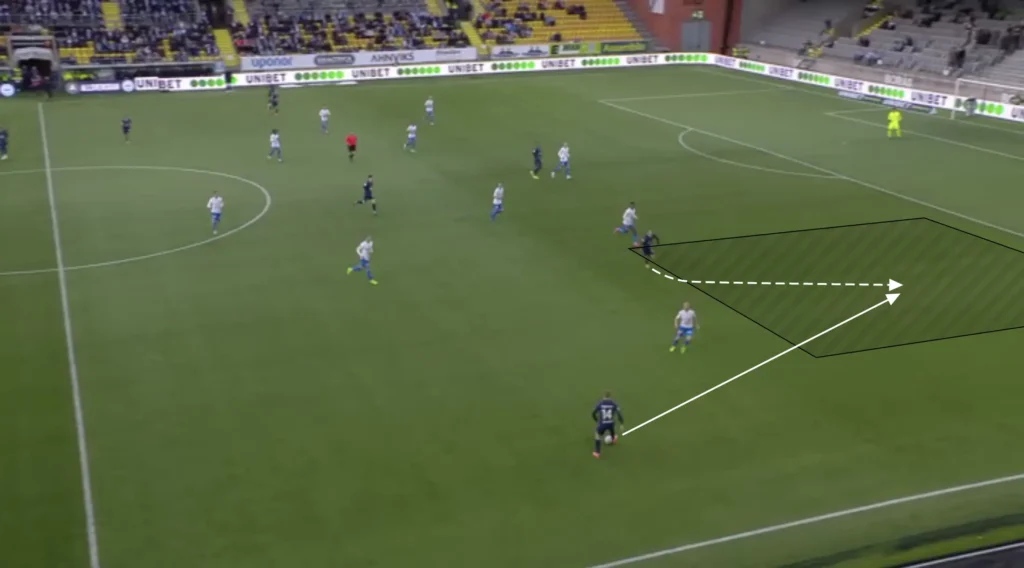
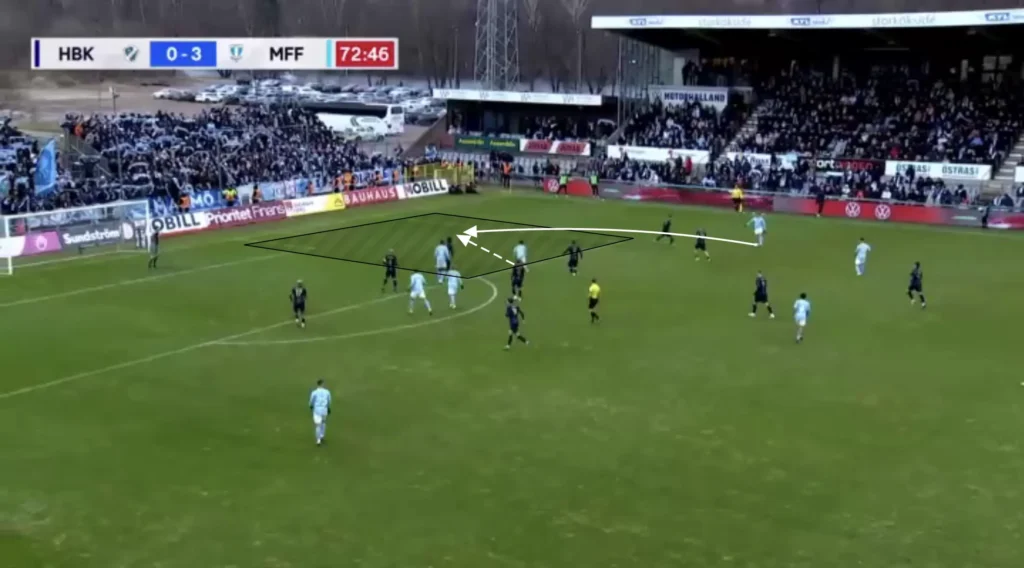
Overlaps
Malmö also use the overlap to produce opportunities in the final third. When a Malmö attacker gets the ball, another Malmö player quickly makes the overlap, creating a 2v1 on the wing. If the opposition fullback drops to cover the overlapping run, the winger could cut inside, taking a shot or combining with a midfielder. If the fullback covers the center, the ball can easily be played to the overlapping player, creating a crossing opportunity.
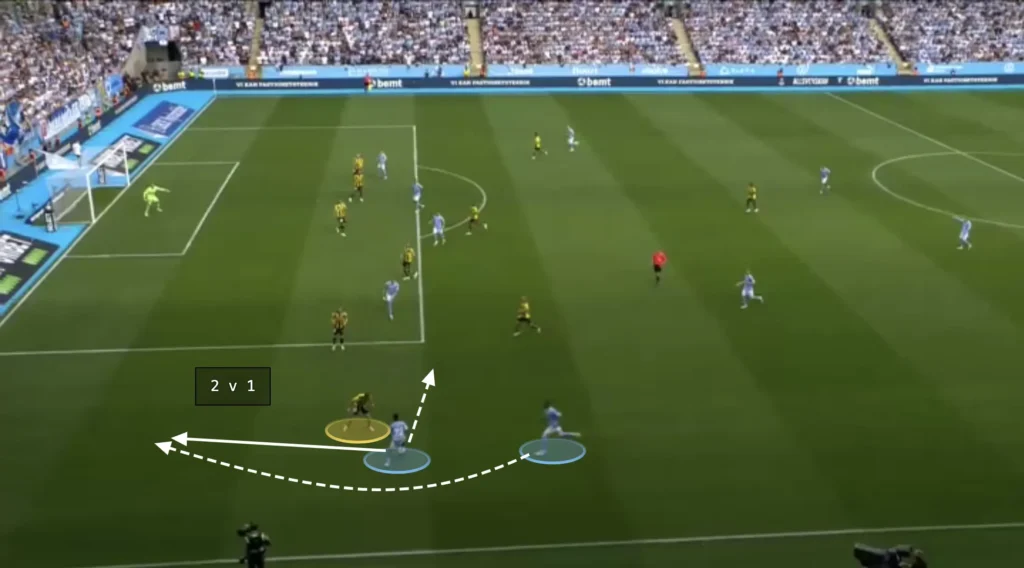
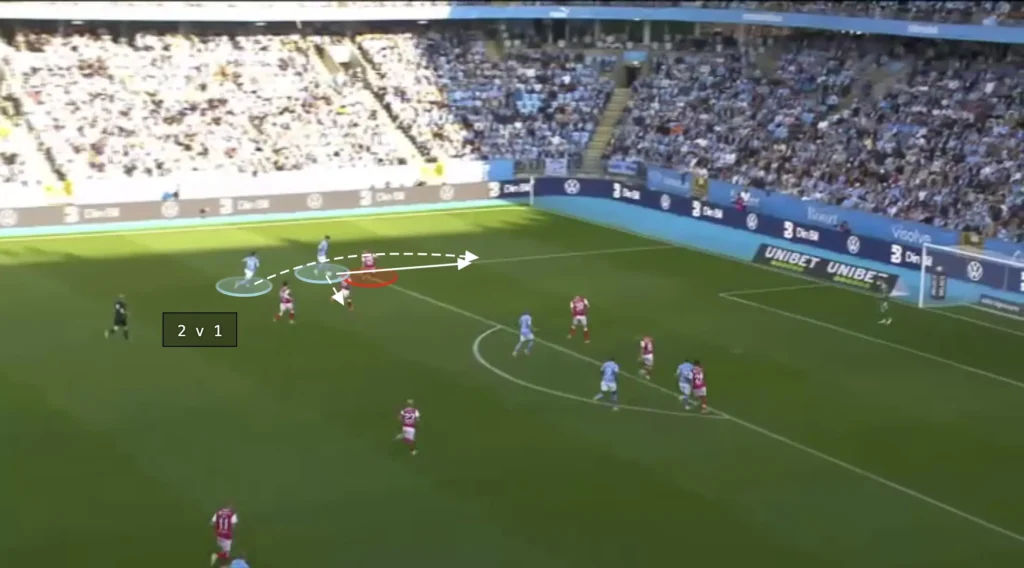
Many Players in the Box
Many Malmö players look to make runs into the box when the ball is in the final third, often getting four or five players into these areas to create overloads. The numerical advantages in the box force the defending team to make decisions and leave some players open.
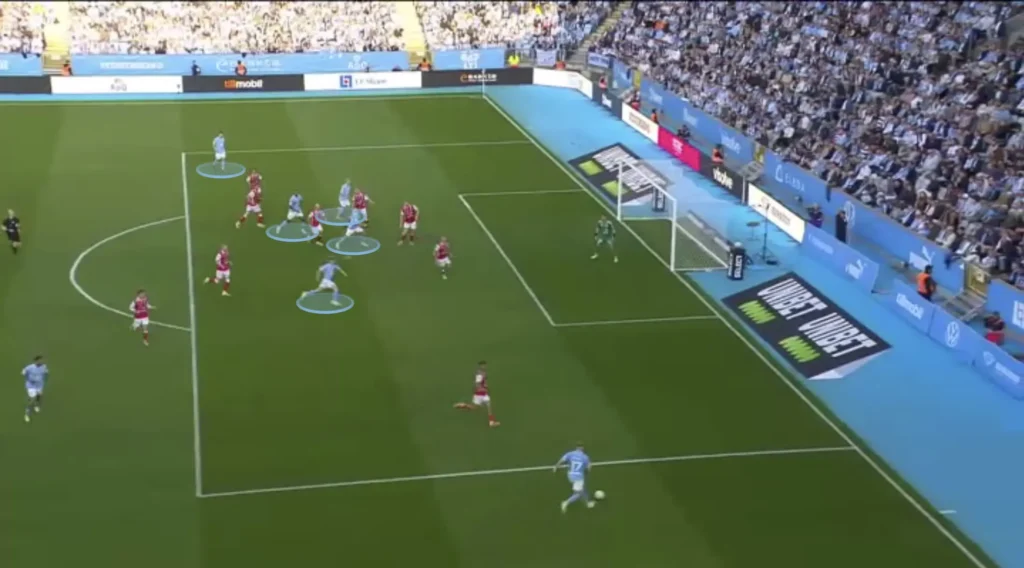
Rydström also wants many Malmö players outside the box, ready for the second balls and cut-backs. They always succeed in pushing down the opposition’s defense, which opens the space in front of the backline. Malmö will often find their midfielders in these spaces who can shoot or combine with an attacker to create goalscoring opportunities.
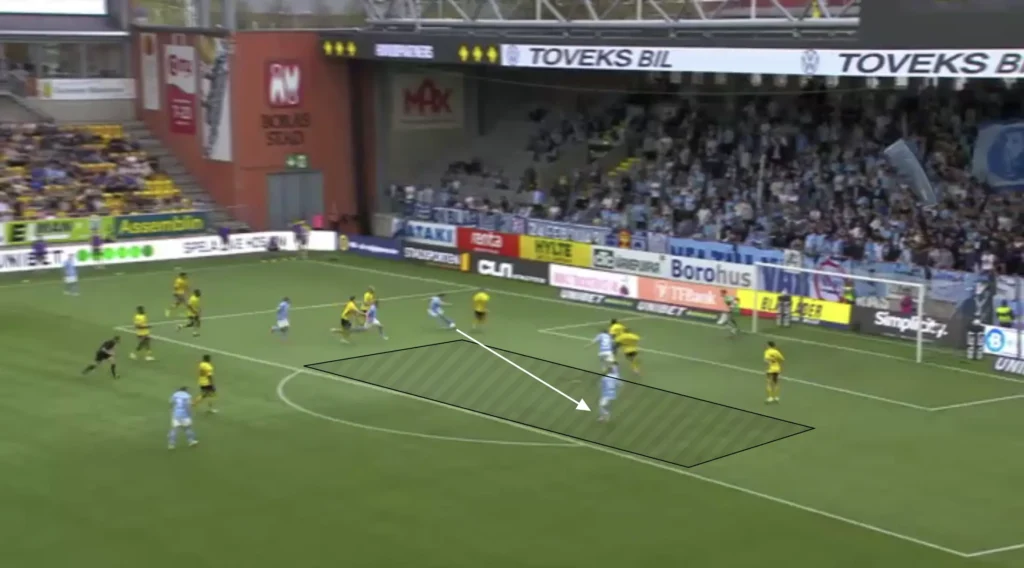
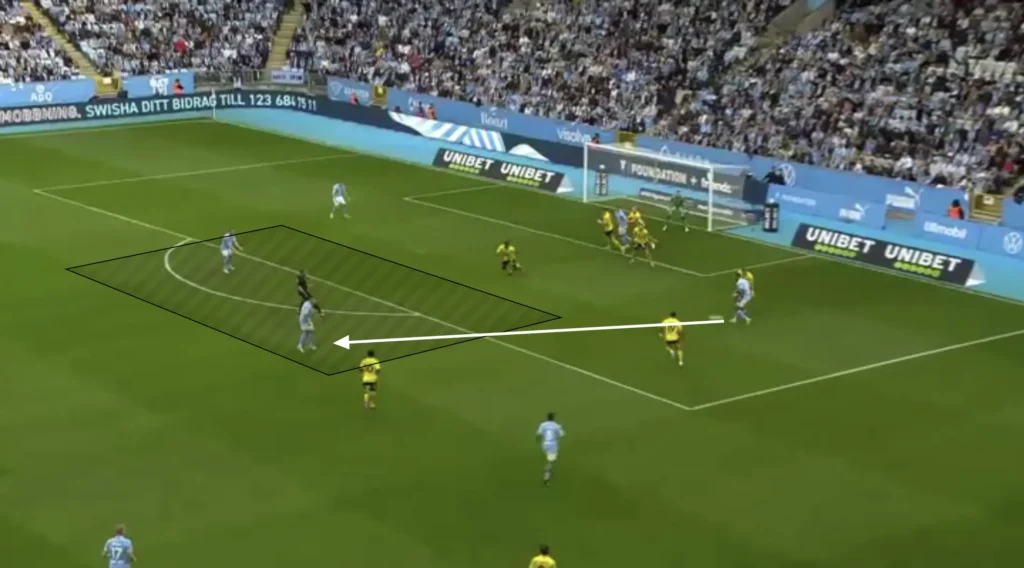
Striker Positioning
Malmö’s striker is always positioned on the blindside of the weak-side center-back.
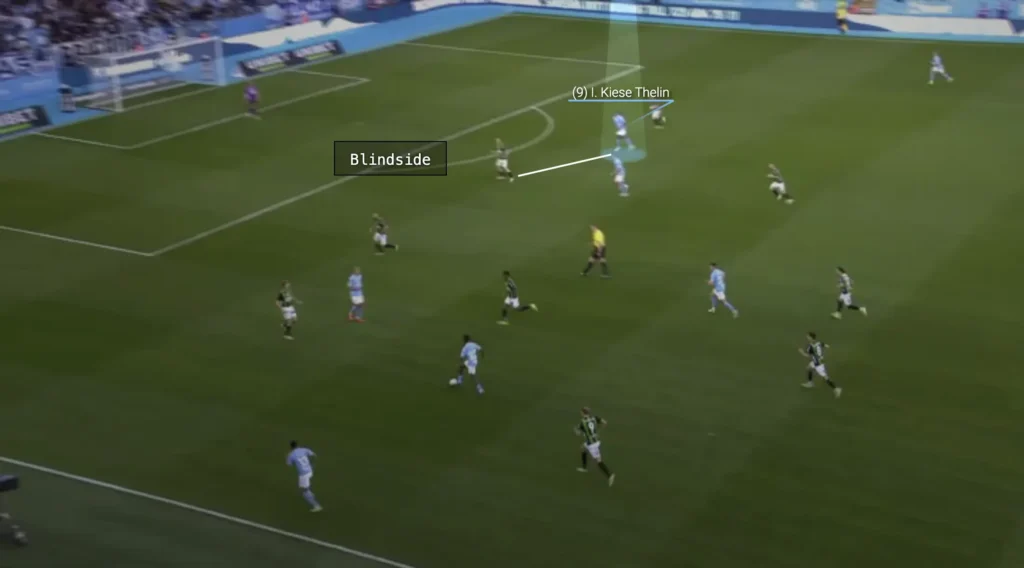
Staying on the blindside of defenders makes it difficult for them to know exactly where you are while you know exactly where they are. The Malmö attackers, therefore, usually run at the back post in crossing situations to be on the blindside and have complete control of their defender. The back post is where the space is, and the center-back’s lack of vision often makes it uncontested. In addition, the player defending that area is usually the fullback, who presumably will be a weaker aerial defender than the center-backs. The Malmö striker, Isaac Kiese Thelin, is the master of the back post, scoring most of his goals from there.
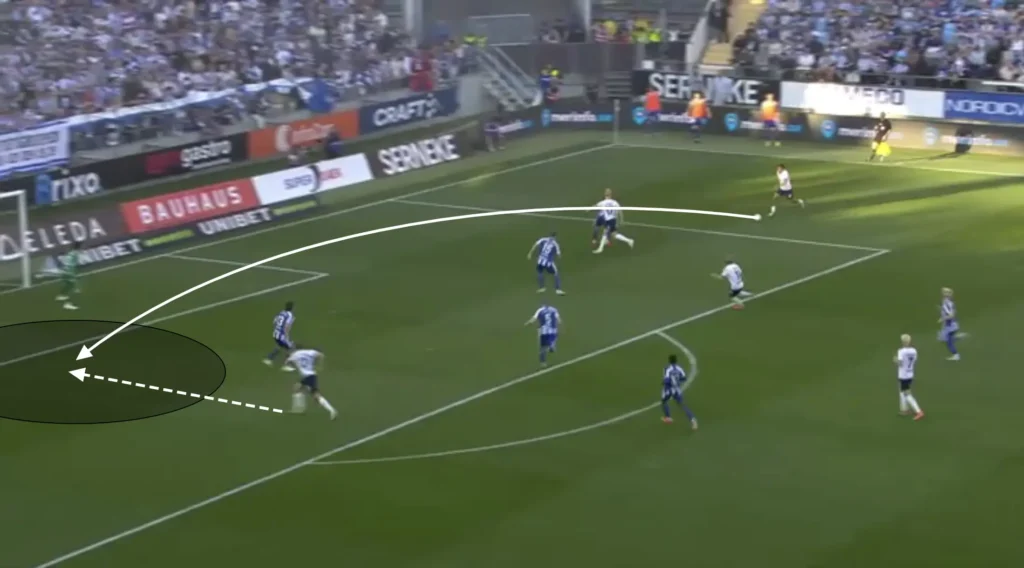
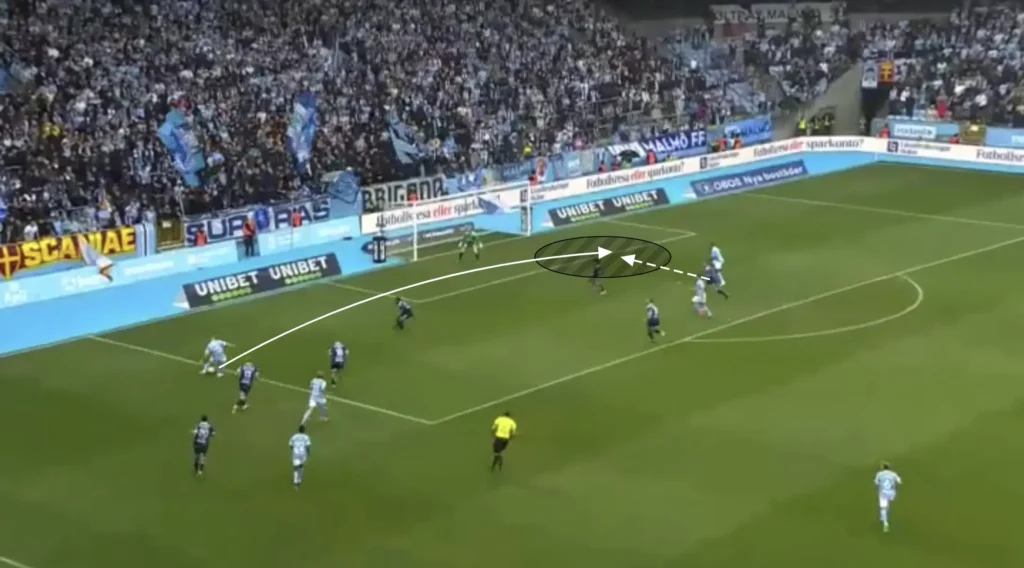
Part of being a good goalscorer is realizing when to not go at the back post and go at the front post instead. Even though the striker usually should go at the back post, sometimes the space is bigger towards the front post. This occurs when an opposition center-back is forced to push out. Kiese Thelin is great at recognizing these patterns and will make the run at the front post when that space is open.
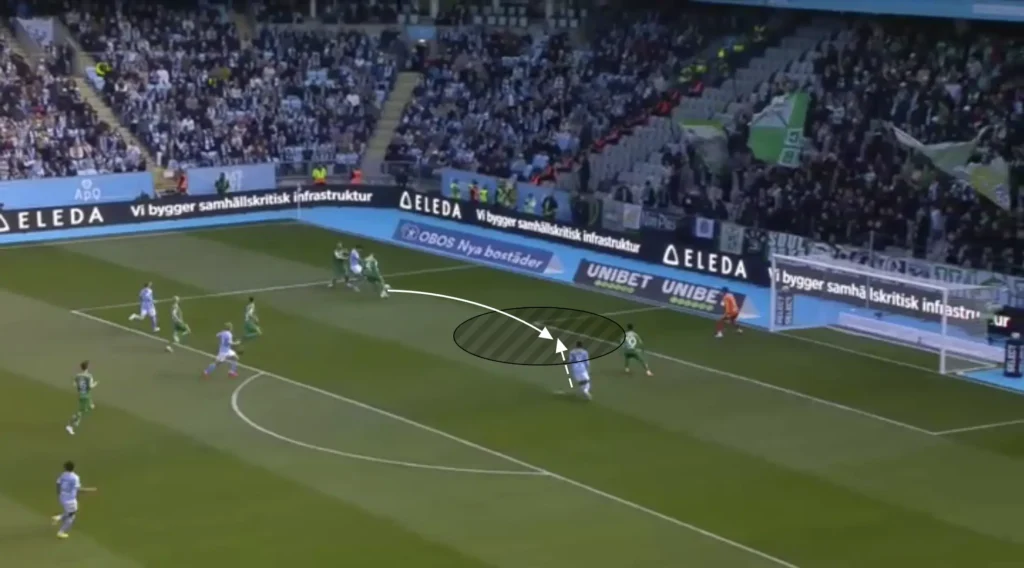
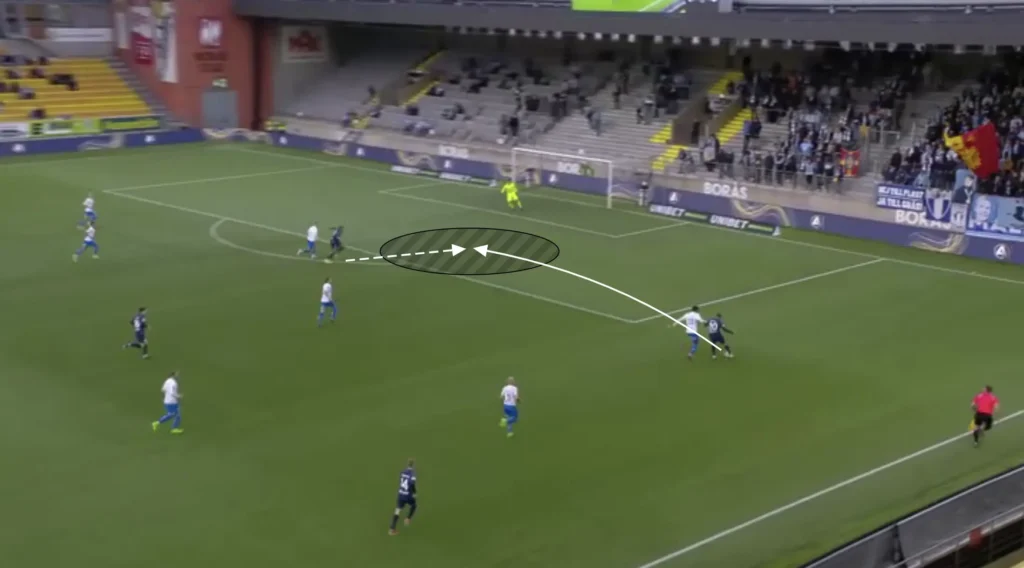
Corners
Malmö score many goals from corners. They have 3 or 4 players every game, who are extremely good in the air, which they are great at exploiting. These 4 players will set up in a bunch towards the back part of the penalty area.
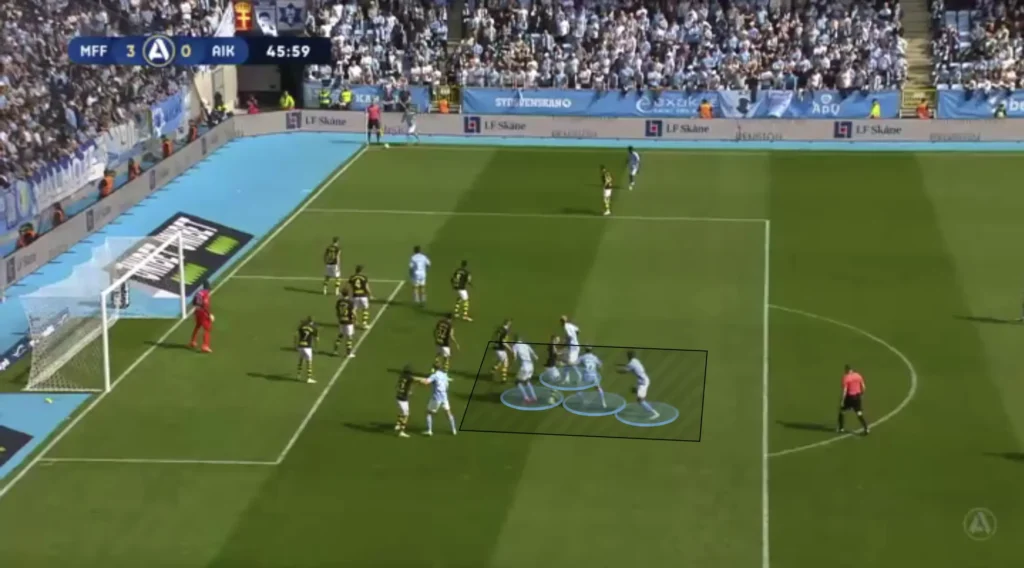
The corners will sometimes be taken toward the bunch in the back part of the box, looking to either score directly from a header or be ready for flick-ons and rebounds.
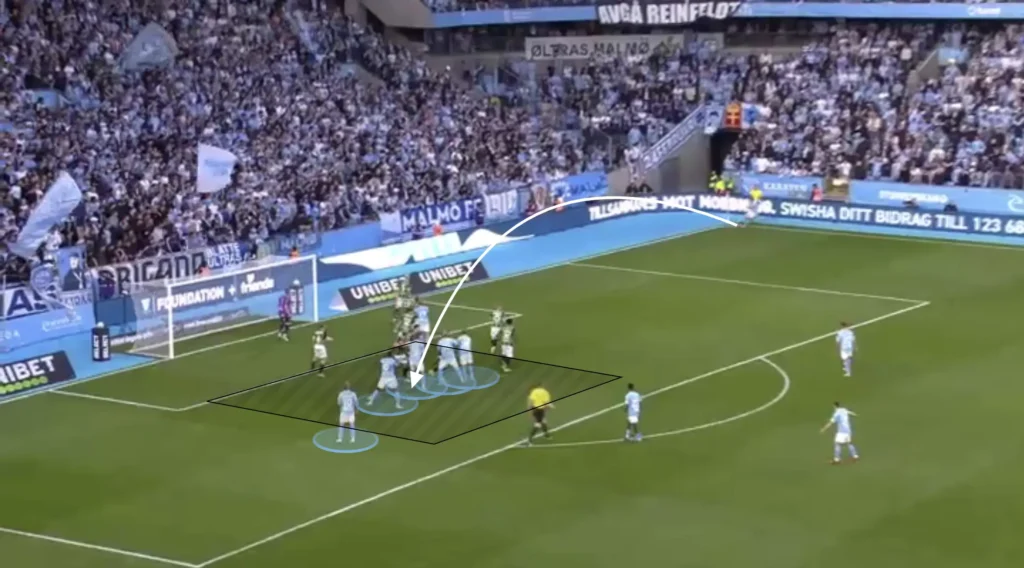
However, most often, the dangermen in the bunch will make runs into different spaces just in front of the goal with the corner coming into whatever space is open.
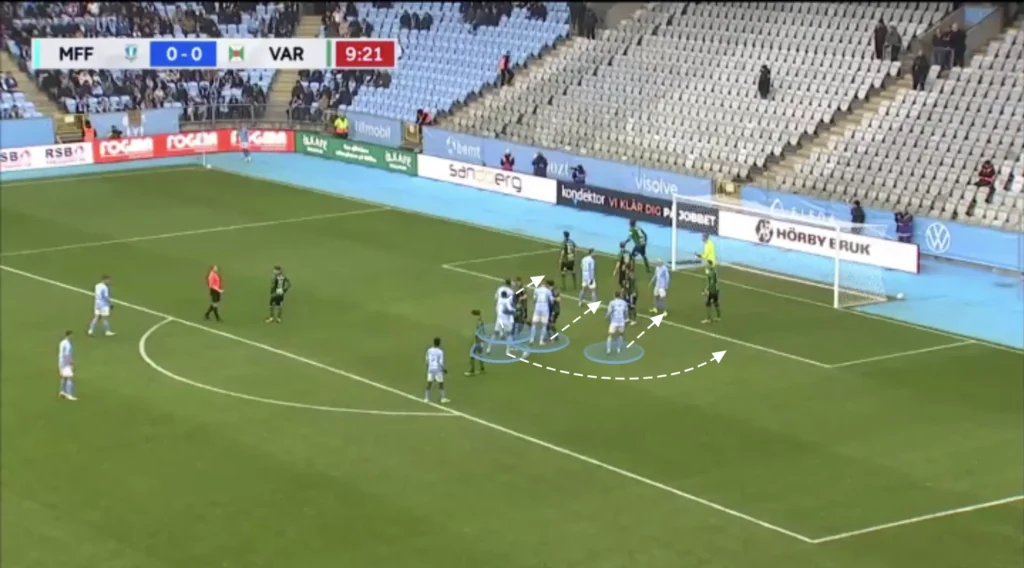
Malmö will also have a lot of players in and around the penalty area to push new crosses into when they don’t score from the corner. If they win the second ball, they always look to cross the ball into the box as fast as possible, utilizing the fact that many of their best heading players are still there. This often catches the defending team, who pushes up without looking around, off guard, allowing Malmö to score easy goals.
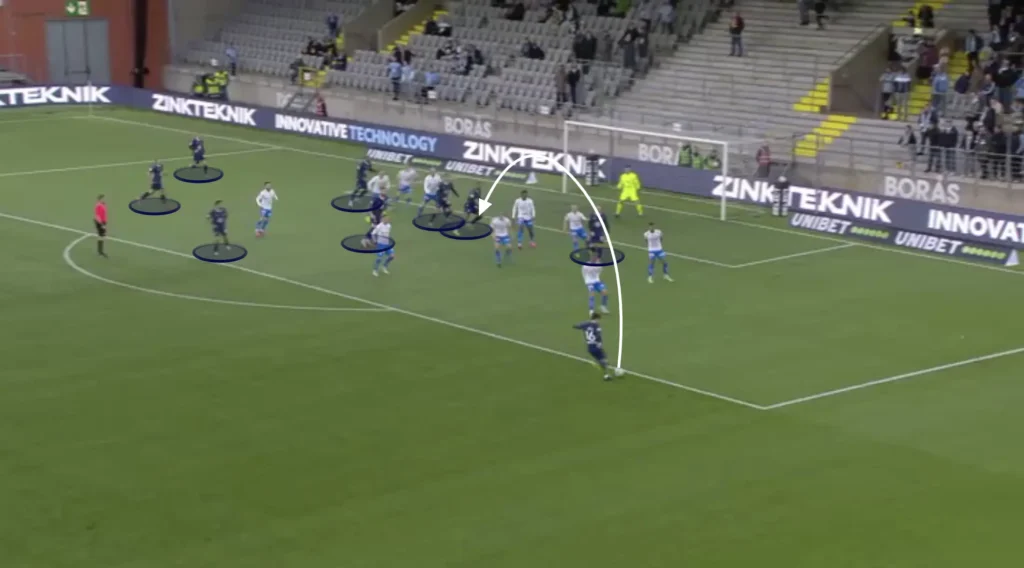
Defending
High Press
Henrik Rydström places much value in being aggressive without the ball. This shows in Malmö’s high pressure. They usually start in a 1-4-2-3-1 shape when pressing the opposition high.
The initial aim of Malmö’s press is to push the opposition to one side. To achieve this, the striker will make an angled run when he presses one of the center-backs, closing the passing lane to the other center-back. From there, the other Malmö players will come across and aggressively push up on the opposition players close to the ball. This makes it difficult for them to find open teammates, usually resulting in Malmö winning the ball.
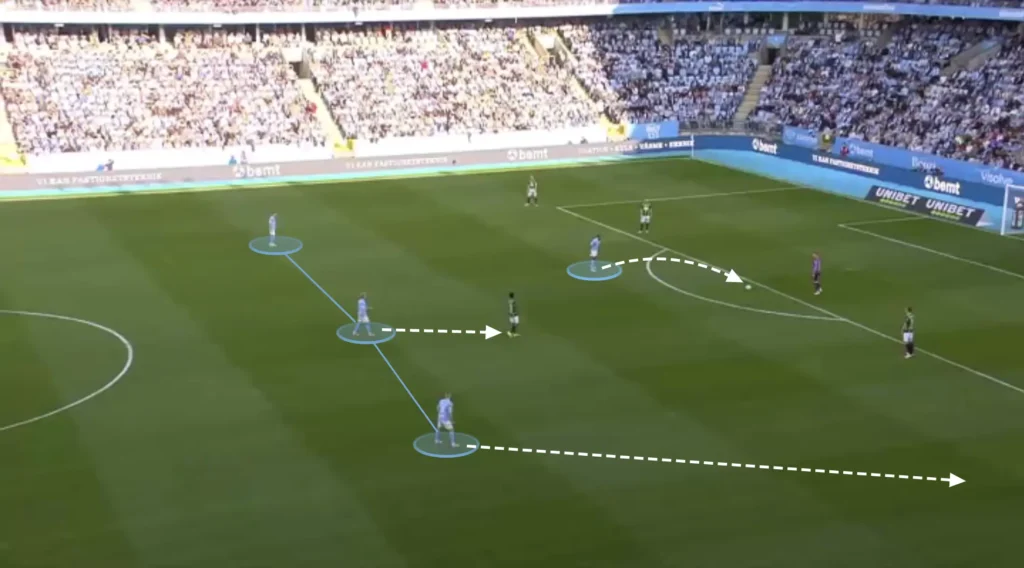
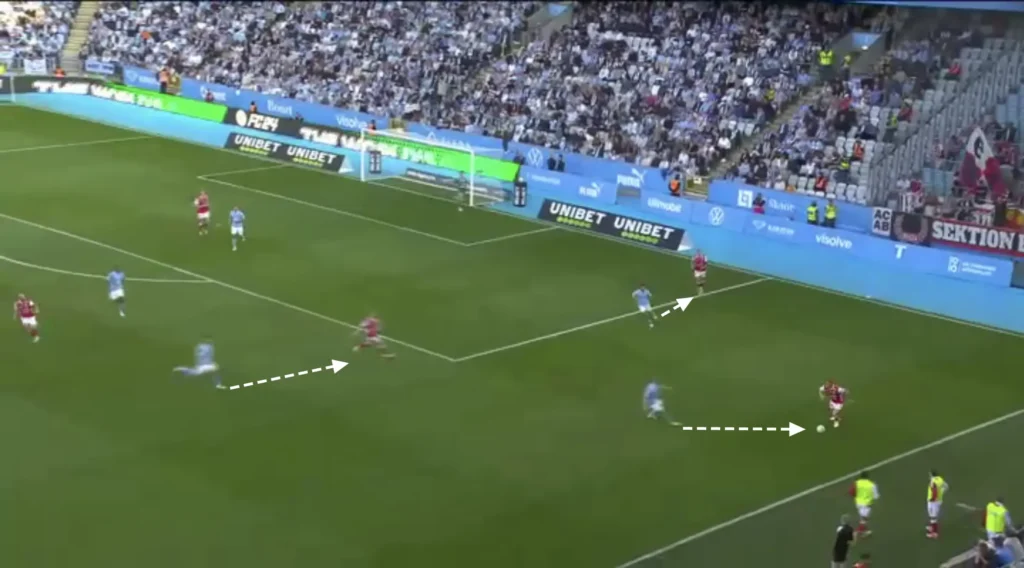
Malmö almost use their high press as an attacking threat, scoring many goals from winning the ball high up the pitch.
Low Press
In the low press, Rydström’s Malmö usually sets up a 1-4-1-4-1 formation. They look to set up in a mid-block, always trying to stay compact, closing the center and forcing the opposition out wide.
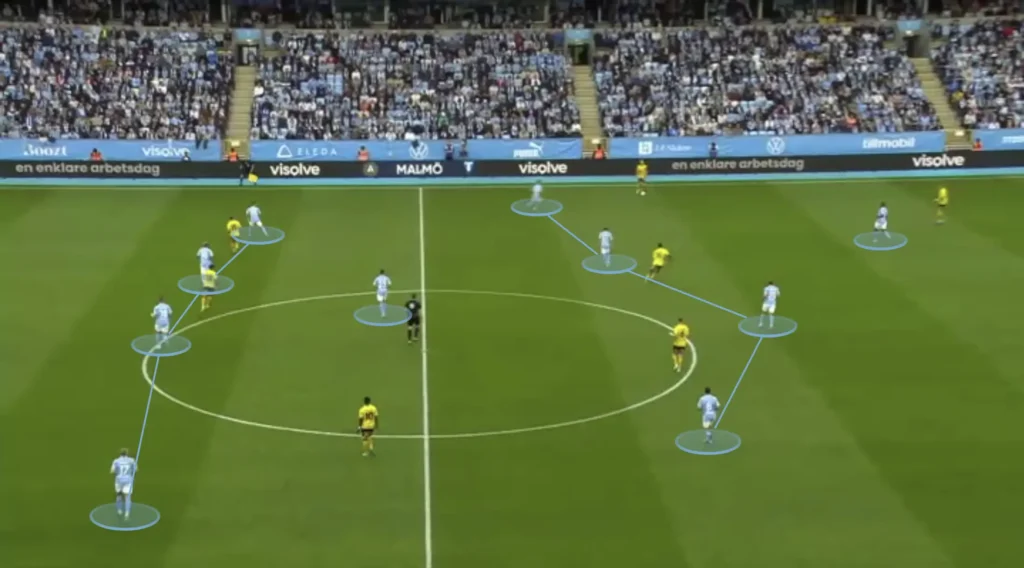
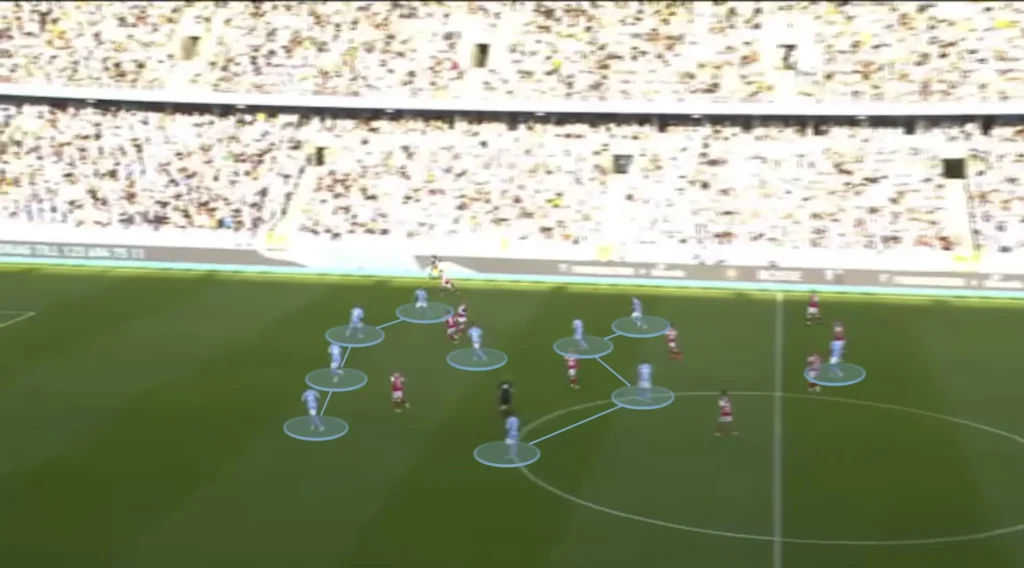
High Backline
One tool that helps to be compact is to play with a high backline, making the space to the midfield line as small as possible. Malmö do this and usually try to keep the highest line they can without leaving the space behind them too open. Defending with a high backline involves positioning the defensive line closer to the midfield, rather than near the goalkeeper. This tactic compresses the space available for the opposing team to operate, disrupting their build-up play and increasing the chances of winning the ball back quickly.
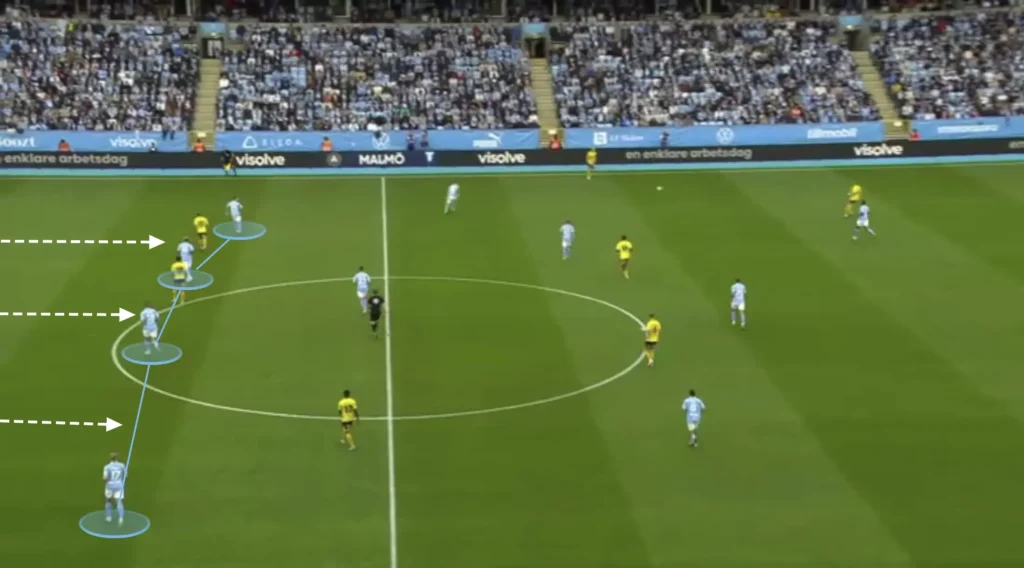
A high backline also allows defenders to support the midfield more effectively, creating numerical superiority in central areas and facilitating quicker transitions from defense to attack. However, it requires defenders with good pace and positional awareness to deal with long balls and prevent opposing attackers from exploiting the space behind. This approach demands constant communication and coordination among the backline to maintain a cohesive and effective defensive structure.
Everyone must be in the same line when defending with a high backline to maintain an effective offside trap, ensure cohesive coverage, and reduce gaps that attackers can exploit. A well-aligned defensive line makes it easier to catch opposing forwards offside, preventing them from receiving the ball in dangerous positions.
Squeezing the Pitch
Malmö always look to squeeze the pitch when defending. This means constantly pushing the team up as much as possible. Every time the opponent plays a slow, sideways pass or a back pass, Malmö’s first line of pressure pushes up, with the rest of the team following to stay compact. When the next pass comes, they push up even more, forcing the opponent back even more. They do this because it pushes the opponent further away from the Malmö goal, making it harder to create chances.
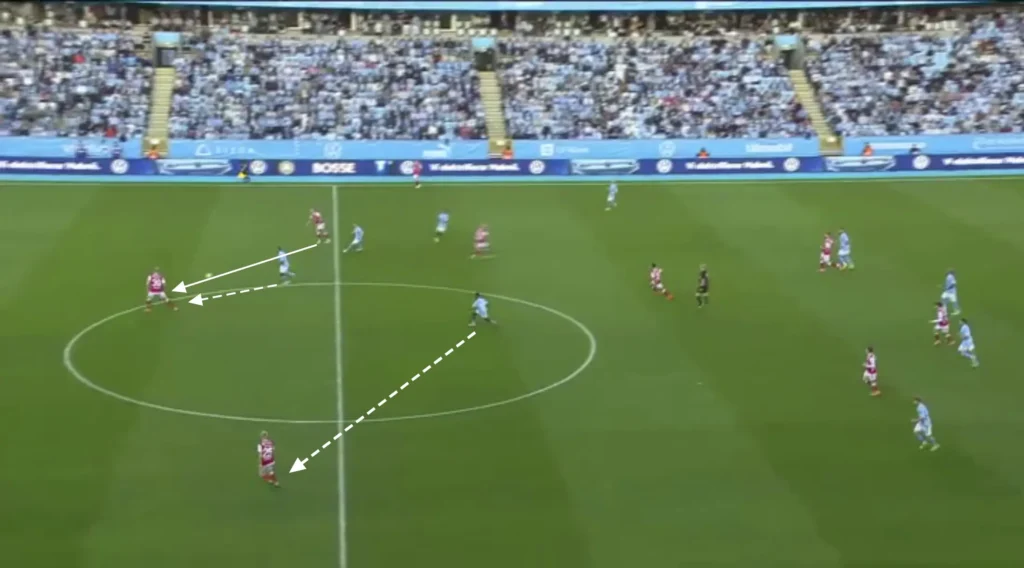
Transitions
Defensive Transitions
Positioning many players on one side and creating numerical advantages creates good conditions in defensive transitions. Many players close to the ball after losing possession means that many players can work towards regaining possession. Therefore, Malmö often successfully regains possession directly after losing it by counterpressing the opposition.
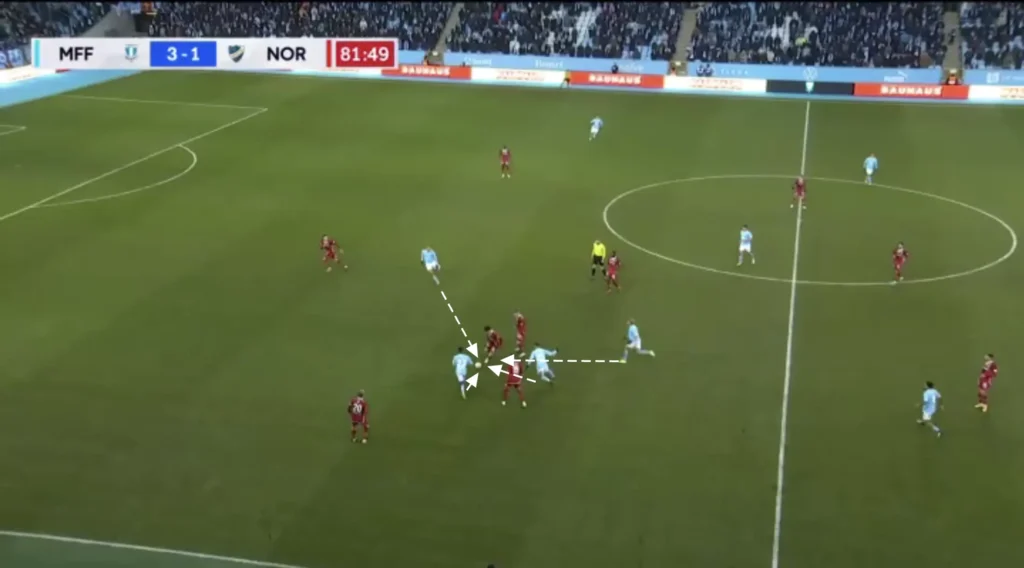
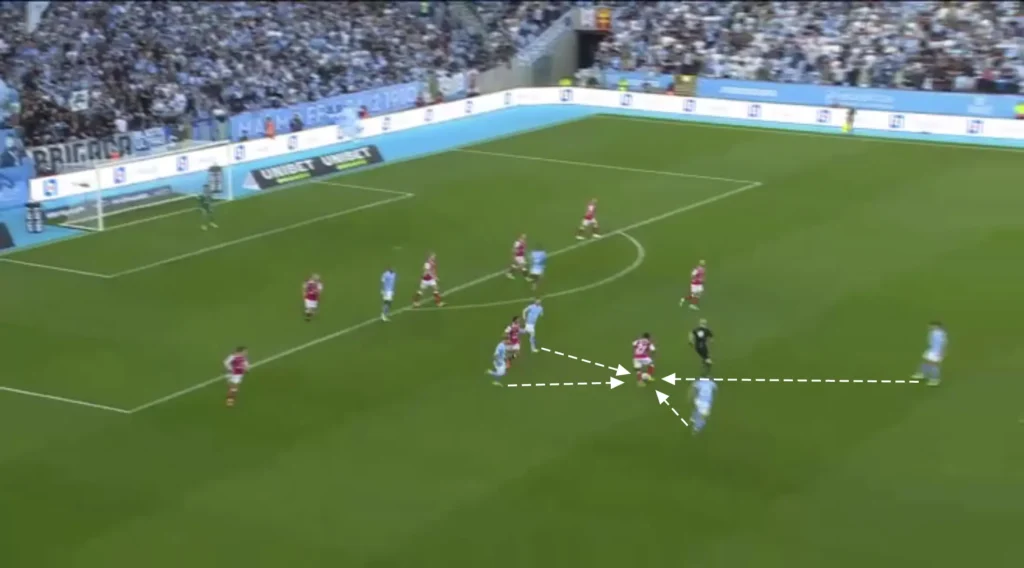
Focusing the play on the side also allows Malmö to use the sideline as an extra defender. When they lose the ball, they can push the opposition towards the sideline and win the ball or stop a counterattack by getting it out for a throw-in.
Attacking Transitions
Recently, Malmö have become more direct in their offensive transitions. They look to counterattack the opposition with a high tempo, often attacking the spaces between the center-backs and fullbacks. In addition, keeping many players centrally while defending enables them to incorporate more players into the counterattacks.
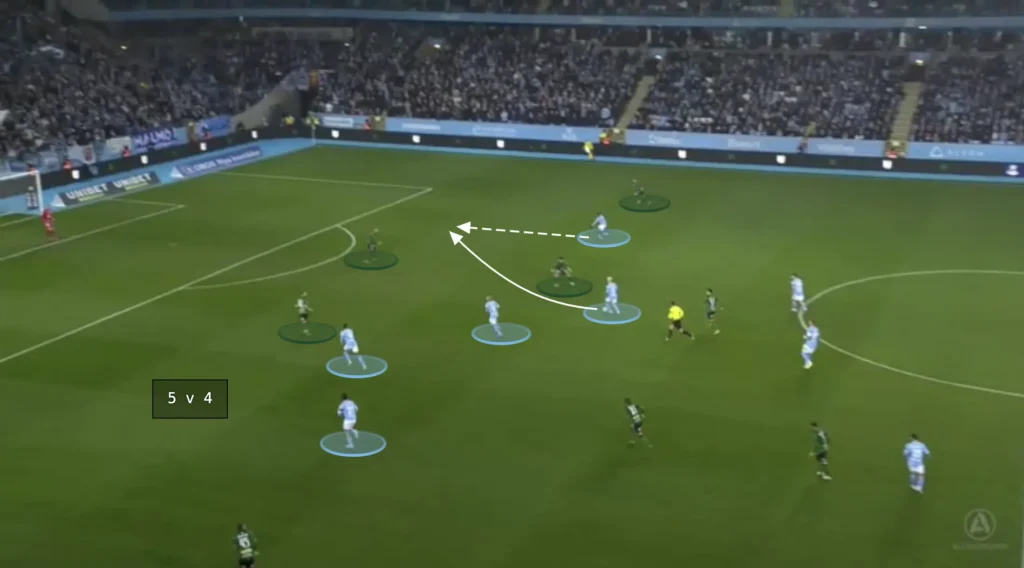
Final Thoughts
In conclusion, Henrik Rydström’s tactical approach at Malmö FF is a testament to his strategic understanding and deep knowledge of the game. His emphasis on possession-based football, combined with fluid formations and disciplined defensive structures, has significantly shaped Malmö FF’s identity on the pitch. By focusing on creating numerical advantages, exploiting space, and maintaining high pressing intensity, Rydström has crafted a team capable of both resilient defense and dynamic attacking play.
As Malmö FF continues to develop under Rydström’s guidance, the tactical principles outlined in this analysis highlight the club’s potential for sustained success. Rydström’s innovative tactics and adaptability promise an exciting future for Malmö FF, making them a formidable force in Swedish football. For fans and analysts alike, the evolution of Malmö FF under Henrik Rydström offers a fascinating glimpse into the tactical sophistication driving the team’s performances.
